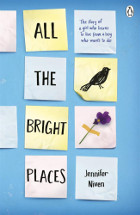All the bright places by Jennifer Niven

Penguin, 2015. ISBN 9780141357034
(Age: 16+) Recommended. Suicide. Grief. Mental Illness.
Bullying. This is the first YA novel from an established American
author, and in this poignant and heart-wrenching novel she addresses
some very complex issues that have personally shaped her life.
Recent YA novels, like John Green's The Fault in our stars,
have addressed serious and challenging issues of life and death and
this novel by Niven is in a very similar style; pathos and humour
interwoven with the challenging issues of family grief, mental
illness and suicide.
All the bright places begins with a suicide rescue as the two
central characters meet while both are staring at the ground from
the high vantage of the school bell tower. 'Is this a good day to
die?' is the opening line. From this precarious start, we are
introduced to Theodore Finch and Violet Markey, who are both dealing
with weighty issues in their life; one who is obviously troubled by
grief and the other unique in his tenuous and unusual hold on life,
sanity and the world. Their encounter begins a friendship and
eventually a romance that takes them wandering through their home
state, all the time gathering unusual memories and experiencing the
roller-coaster ride of romance, mental illness and the life-altering
grief that comes with an untimely death. This sounds incredibly
grim, and yet there is real humour and joy as we see life through
the eyes of the charming yet strange Theodore, and the
slowly blossoming Violet. The impact of grief on Violet is to rob
her of creativity, and yet Theodore seems able to draw out of her a
new vision of the world and of life. References connecting the
central characters to the words of Virginia Woolf and other literary
masters who battled (and lost to) depression, are scattered
throughout the book. Relationships with adults are secondary in this
book, but seen through the eyes of the young people, we get a
glimpse of the difficulty that depression, mental illness and grief
are for teens. The adults too, are battling their own issues, and
counselling and strategies to move forward are not clear cut.
Bullying and violence issues are also highlighted in the book and
demonstrate that young people do not deal well with mental illness.
School is not always a good place to find 'bright places'.
My concern with this book is that the issues it deals with may be
too weighty for some young people to handle well. Recommended, with
some trepidation, for 16+ readers, as identifying the vulnerable is
not always easy, and this book may be too confronting for some,
particularly for those battling their own mental health issues.
However the book's transformation to film will invariably mean that
younger readers will be wanting to read this too.
Carolyn Hull